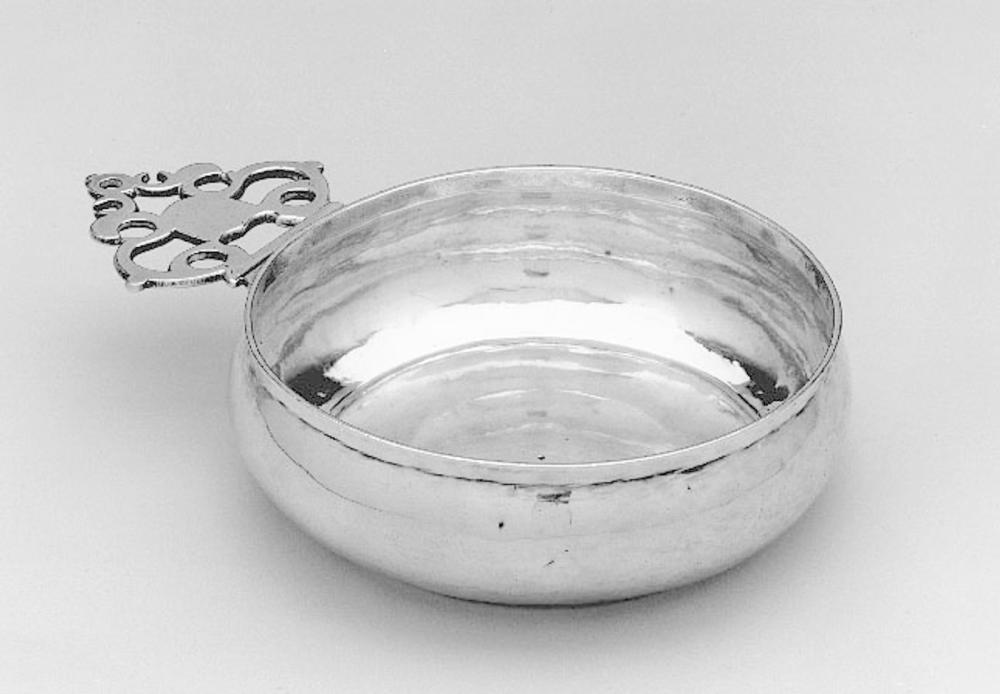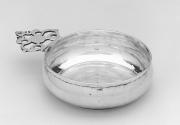Advanced Search
Porringer, Child's
Edward Winslow (American, 1669–1753)
about 1687–1720
Object Place: Boston, Massachusetts
Medium/Technique
Silver
Dimensions
3.9 x 17 cm (1 9/16 x 6 11/16 in.)
Credit Line
Gift of the Wunsch Americana Foundation in recognition of Kathryn C. Buhler
Accession Number1983.760
CollectionsAmericas
ClassificationsSilver hollowware
Edward Winslow is known for his skill in fashioning ambitious forms. His chocolate pots, candlesticks, and sugar boxes are considered among the most outstanding accomplishments of colonial American silversmiths.
Following his likely apprenticeship to Jeremiah Dummer, which would have ended about 1690, Winslow enjoyed his most productive period from about 1695 to about 1720, even as his growing civic and military duties required him to take on journeymen to handle daily shop activities. He was prominent in civil and military affairs in Boston beginning about 1700, when he became a member of the Ancient and Honorable Artillery Company. In addition to several other offices throughout his life, in 1743, at age seventy-four, Winslow was appointed judge of the Inferior Court of Common Pleas, a post he held until his death in 1753.
This child’s porringer offers evidence of one means of the transmission of silver styles from England to America. Any enterprising silversmith who found himself with London-made goods, whether for repair or for sale, would have found it a simple task to appropriate useful decorative elements to cast for future use. It may have been especially attractive for Winslow to cast a small porringer handle. Since commissions for children’s silver were infrequent, he would have been able to satisfy a patron without resorting to the labor-intensive fabrication of a new handle.
The unusual strike of the Winslow mark over another by maker “WR” indicates that the Boston silversmith had access to an English porringer, which he cast for his own use. The original porringer handle was made by an unnamed London goldsmith whose mark was recorded in 1674 – 75. A second porringer carrying a vestige of this English mark was made by Rhode Island silversmith Isaac Anthony (1690 – 1773), likely a Winslow apprentice. The “WR” mark occurrs in the same location as on the Winslow vessel. The handles of both porringers are identical, and they undoubtedly came from the same mold.
Given the relationship between the two vessels, Anthony probably obtained a cast of the handle during his years with Winslow. Anthony was born in Portsmouth, Rhode Island, but appeared in Boston by 1712, when he was taken to court for debt. Two years later, he married Marcy Chamberlain of Boston in a Quaker service; he purchased goods from Boston stationer Daniel Henchman in 1715. Anthony probably became Winslow’s apprentice through the influence of Rhode Island silversmiths Samuel Vernon (1683 – 1737) and John Coddington (1690 – 1743) and Boston silversmith Thomas Savage Sr. (1664 – 1749), to whom Winslow was related through his mother, Elizabeth Hutchinson (1639 – 1728).
This text has been adapted from "Silver of the Americas, 1600-2000," edited by Jeannine Falino and Gerald W.R. Ward, published in 2008 by the MFA. Complete references can be found in that publication.
Following his likely apprenticeship to Jeremiah Dummer, which would have ended about 1690, Winslow enjoyed his most productive period from about 1695 to about 1720, even as his growing civic and military duties required him to take on journeymen to handle daily shop activities. He was prominent in civil and military affairs in Boston beginning about 1700, when he became a member of the Ancient and Honorable Artillery Company. In addition to several other offices throughout his life, in 1743, at age seventy-four, Winslow was appointed judge of the Inferior Court of Common Pleas, a post he held until his death in 1753.
This child’s porringer offers evidence of one means of the transmission of silver styles from England to America. Any enterprising silversmith who found himself with London-made goods, whether for repair or for sale, would have found it a simple task to appropriate useful decorative elements to cast for future use. It may have been especially attractive for Winslow to cast a small porringer handle. Since commissions for children’s silver were infrequent, he would have been able to satisfy a patron without resorting to the labor-intensive fabrication of a new handle.
The unusual strike of the Winslow mark over another by maker “WR” indicates that the Boston silversmith had access to an English porringer, which he cast for his own use. The original porringer handle was made by an unnamed London goldsmith whose mark was recorded in 1674 – 75. A second porringer carrying a vestige of this English mark was made by Rhode Island silversmith Isaac Anthony (1690 – 1773), likely a Winslow apprentice. The “WR” mark occurrs in the same location as on the Winslow vessel. The handles of both porringers are identical, and they undoubtedly came from the same mold.
Given the relationship between the two vessels, Anthony probably obtained a cast of the handle during his years with Winslow. Anthony was born in Portsmouth, Rhode Island, but appeared in Boston by 1712, when he was taken to court for debt. Two years later, he married Marcy Chamberlain of Boston in a Quaker service; he purchased goods from Boston stationer Daniel Henchman in 1715. Anthony probably became Winslow’s apprentice through the influence of Rhode Island silversmiths Samuel Vernon (1683 – 1737) and John Coddington (1690 – 1743) and Boston silversmith Thomas Savage Sr. (1664 – 1749), to whom Winslow was related through his mother, Elizabeth Hutchinson (1639 – 1728).
This text has been adapted from "Silver of the Americas, 1600-2000," edited by Jeannine Falino and Gerald W.R. Ward, published in 2008 by the MFA. Complete references can be found in that publication.
DescriptionThe small raised porringer with geometric handle has convex sides and a slightly everted rim. The faint small dome in the bottom of the bowl has a center punch. The cast handle has pronounced filing marks on its underside, perpendicular to bowl.
Marks
On the back of handle, "EW" over a fleur-de-lis in a shaped cartouche, struck over the faint mark of "WR" conjoined with a coronet above, within a circle. To left of handle, incomplete mark "EW" over a fleur-de-lis within a shaped cartouche.
InscriptionsScript inscription in a later hand reads "Mary Lowell / 1833 / Mary Lowell Coolidge / 1891" on underside of bowl.
ProvenanceMary Lowell (1833-1915) of Waltham, Massachusetts, m. 1856 Algernon (Sidney) Coolidge (1830-1912); gift to her granddaughter and namesake Mary Lowell Coolidge (1891-1958). 1971, purchased from Gebelein Silversmiths, Boston by Eric M Wunsch; 1983, gift of Mr Wunsch to MFA. (Accession date: Jan 18, 1984)




